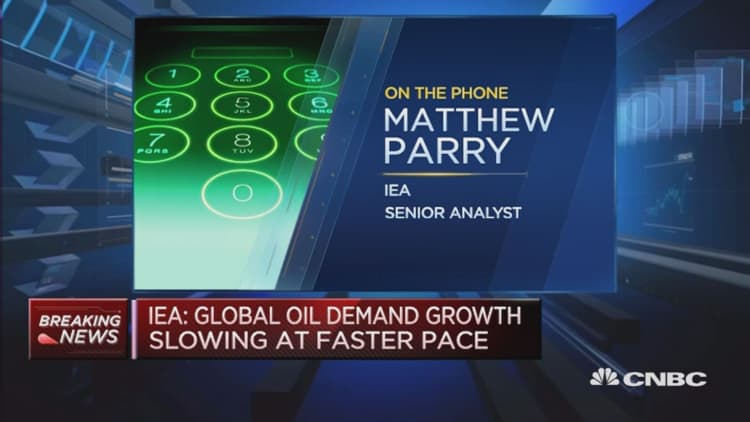
Global oil demand growth is slowing at a faster pace than first thought, the International Energy Agency (IEA) said in its latest market update, warning that markets would have to wait "a while longer" for markets to rebalance.
"Global oil demand growth is slowing at a faster pace than initially predicted. For 2016, a gain of 1.3 million barrels a day (mb/d) is expected," the IEA said in its September report published on Tuesday, equating to a downgrade of 100,000 barrels a day from its previous forecast.
The downgrade was "due to a more pronounced slowdown" in the third quarter of 2016, it said before forecasting a further slowing next year. "Momentum eases further to 1.2 mb/d in 2017 as underlying macroeconomic conditions remain uncertain."
The predictions will be worrying for oil markets at a time when a delicate rebalancing of supply and demand is hoped to be taking place. Oil prices have dropped steadily since mid-2014 on the back of a glut in global oil supply and the failure of demand to keep pace.
The glut was exacerbated by OPEC, a 14-member oil producing group which includes major Middle Eastern producers, to defend its market share in the face of rivals rather than the oil price. The strategy has put pressure on the cartel's members, who have seen oil export revenues fall, while having the planned effect of putting rival non-OPEC producers out of action.
The IEA noted on Tuesday that non-OPEC supplies continued to decline. "World oil supplies fell by 300,000 barrels a day in August, dragged lower by declines in non-OPEC," the IEA said although it noted that this decline in global supply was offset by a rise in OPEC production, which has defensively kept its own output at record levels.
"At 96.9 mb/d, global oil output was 300,000 b/d below a year ago, but near-record OPEC supply just about offset steep non-OPEC declines," the IEA said.
Uphill struggle ahead
The price of benchmark Brent crude and West Texas Intermediate (WTI) are currently hovering around the $45-$47 mark with prices fluctuating every time a piece of data signals whether oil demand could rise or fall and on how much of the oil glut remains.
On Tuesday, for example, oil prices fell in early trade on Tuesday on concerns over increased drilling in the United States, Reuters reported, and as investors took profits after oil prices rose close to 1 percent in the previous session.(103934220)
Ultimately, oil markets are currently in what the IEA called a waiting game, pondering when demand and supply will return to balance. The outlook was not clear or necessarily rosy, the agency cautioned.
"When will the world oil market return to balance? That is the big question today. With the price of oil at current levels, one would expect supply to contract and demand to grow strongly. However, the opposite now seems to be happening. Demand growth is slowing and supply is rising. Consequently, stocks of oil in OECD countries are swelling to levels never seen before," the IEA said.
"Our latest numbers provide some clues as to why. Recent pillars of demand growth – China and India – are wobbling. After more than a year with oil hovering around $50 a barrel, the stimulus from cheaper fuel is fading. Economic worries in developing countries haven't helped either. Unexpected gains in Europe have vanished, while momentum in the U.S. has slowed dramatically."
"The result has been a slump in oil demand growth from a robust 1.4 mb/d in the second quarter to a two-year low of 0.8 mb/d in the third. Even with a modest weather-related uptick forecast for the end of the year, oil demand growth in 2016 will struggle to get above 1.3 mb/d. Refiners are clearly losing their appetite for more crude oil.
During the fourth quarter, they are expected to process only 0.1 mb/d more crude than a year ago."
As such, the IEA warned that the data suggested "that this supply-demand dynamic may not change significantly in the coming months."
"As a result, supply will continue to outpace demand at least through the first half of next year. Global inventories will continue to grow: OECD stockpiles in July smashed through the 3.1 billion barrel wall. As for the market's return to balance - it looks like we may have to wait a while longer."


